This is the heartbreaking image of the GSLV Mk II crashing into the Bay of Bengal on April 15, 2010, taking with it the nation’s hope of a true heavy lifting rocket.
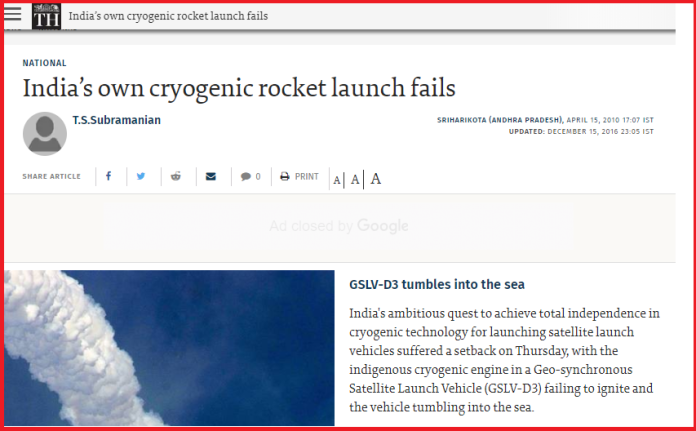
At the heart of the disaster was the failure of the indigenous cryogenic engine. A cryogenic engine is the most powerful kind of rocket engine, which is the only way to put heavy satellites into orbit. This is the technology that helped the Americans reach the moon. Without mastering the cryogenic engine, there is no way that India could enter the big leagues of the global space club.
Of course, nobody in the world would be willing to just give us this technology. We would have to figure it out on our own.
What if I were to tell you that decades ago, we had one such extraordinary scientist who was working on the indigenous cryogenic engine? And that he was taken off the job, labelled a traitor and his life destroyed by our ‘secular’ governments?
Would you ever be able to forgive them?
Meet Nambi Narayanan, who was awarded the Padma Bhushan yesterday.
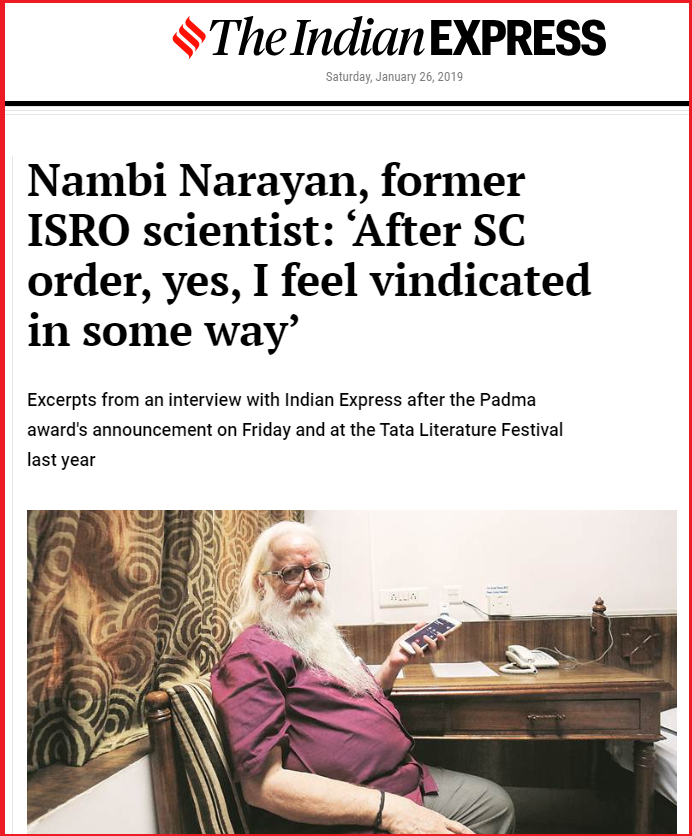
Scientist. Patriot. Genius.
Remember the PSLV, which powered the Mangalyaan in 2014 and planted the Indian flag on Mars? The PSLV which powered Chandrayaan in 2008 and confirmed for all humanity that there is definitely water ice on the moon? All nations of the world, you are very welcome.
The PSLV has always made us proud. The PSLV rocket runs on the indigenous “Vikas engine” and Nambi Narayanan was instrumental in building it.
In the 1990s, Nambi Narayanan was one of India’s top scientists, working on the indigenous cryogenic engine. Earlier, India had tried to buy some of this technology from the Russians, but the Americans fought tooth and nail and blocked it. As I said, those who have this technology will guard it jealously. We are on our own.
Then, it all happened.
In 1994, Nambi Narayanan was suddenly accused of being a spy and leaking sensitive rocket information to foreign agents. He was arrested and thrown into jail. His career was over.
And with Nambi Narayanan’s arrest in 1994, India’s dream of building an indigenous cryogenic engine was set back by decades. As late as 2010, India was still struggling to pick up the pieces and complete that cryogenic engine.
Success in building that cryogenic engine finally came in January 2014.
Who will pay India back for those 20 years between 1994 and 2014? Not Indian ‘secularism’, I assure you.
As Nambi Narayanan’s case made it to court, the wheels of justice began to turn. The CBI admitted that the IB had simply cooked up the case.

The same 1998 Outlook article also tells us what the CBI said in its report on June 3, 1996.
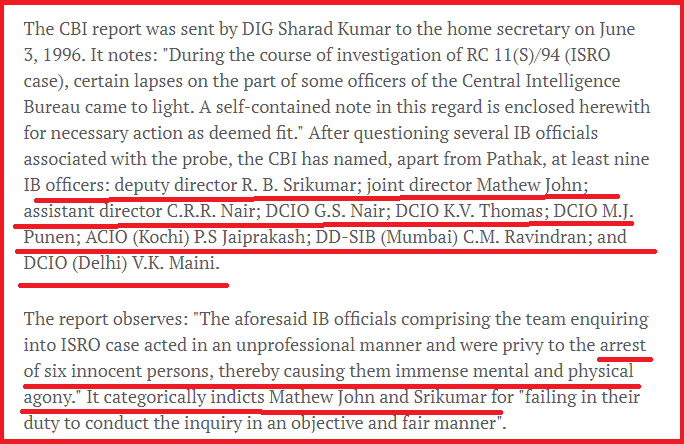
“Arrest of six innocent persons, thereby causing them immense mental and physical agony”
What an injustice!
Wait, there’s more.
Notice that name: R B Sreekumar who, as per the Outlook article, was categorically indicted for failing in duty to conduct the inquiry in an objective and fair manner?
Now, where else have I heard about R B Sreekumar?
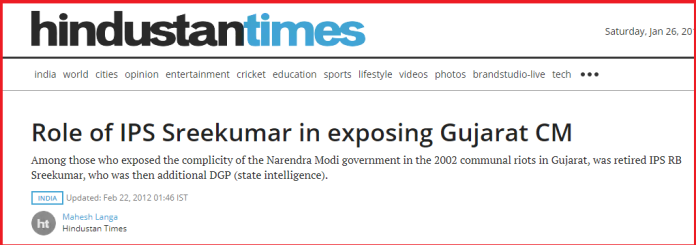
Ah! Remembered. It turns out that R B Sreekumar is quite a famous man, reputed for his pursuit of justice.
Here’s more.

And of course:
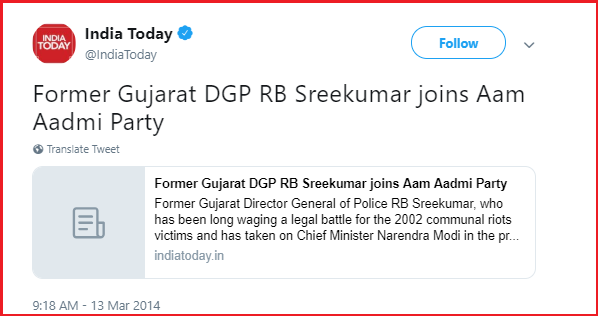
Over the course of his illustrious career, R B Sreekumar has won many hearts, many awards and numerous distinctions. Here is one wonderful memory from this photograph published in The Hindu on April 24, 2008.

On the left is a beaming R B Sreekumar receiving the Award for “Best Malayali Police Officer”. The man presenting him with the award is then State Secretary of the CPI(M) Pinarayi Vijayan, who is now the Chief Minister of Kerala. In the centre, you see “human rights activist” Teesta Setalvad, who is all smiles.
Ecosystem, in a nutshell.
Don’t get too angry at just the CPIM and Pinarayi Vijayan. In 2011, Congress Chief Minister Oommen Chandy, then just 43 days into office, dropped all charges against police officials who had been accused of misconduct in the Nambi Narayanan case.

Police officer Siby Mathews, whose team had come out with the espionage theory, rose to become the Chief Information Commissioner of Kerala. Of course, he did.
This is the sinister soup of Indian ‘secularism’.
Meanwhile, Nambi Narayanan was still fighting for his dignity and a bit of justice.

Finally! In Sept 2018! The Supreme Court awarded him Rs 50 lakh compensation. And it also created a Committee headed by Justice D K Jain to inquire into the role of Kerala Police Officers. This second part of the Supreme Court decision, the part about digging out what Kerala Police officers might have done, did not receive much coverage in media headlines. For reasons of Indian ‘secularism’, of course.
Sometime in early 2016, the Modi government cracked down on some student union malcontents at JNU. Those “dissenters” became household names, celebrity free speech activists, addressing packed crowds of ‘liberals’ in the city after city. A group of otherwise unemployable “students”, sitting out their degree programs in something or another at JNU for long years on taxpayer money.
In comparison, how many people know this story of Nambi Narayanan, the man whose career and life was crushed under the weight of Indian secularism? His fault is that he was building rocket engines for India and not raising slogans of “Bharat ke tukde“. So Indian ‘secularism’ finished him.
Oh, and did I mention that Nambi Narayanan took just 10 months to finish his degree from Princeton? Just 10 months? JNU’s celebrity students must have spent more than 10 months in TV studios alone, bragging about all the intellectual thinking they are doing on our behalf.
But Indian ‘secularism’ finished Nambi Narayanan. It took India 20 more years to build the cryogenic engine he was working on.
It’s Republic Day, a moment to celebrate the “Sovereign Socialist Secular Democratic Republic of India” as it says at the beginning of the Constitution. The words “socialist” and “secular” were inserted by Indira Gandhi at the time of the Emergency. They say that the truth will set you free, but first, it will piss you off.



